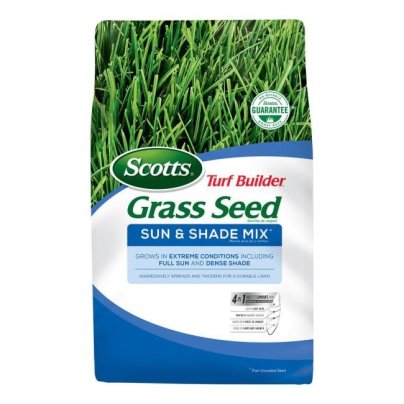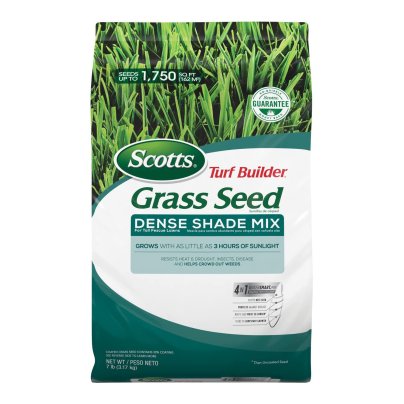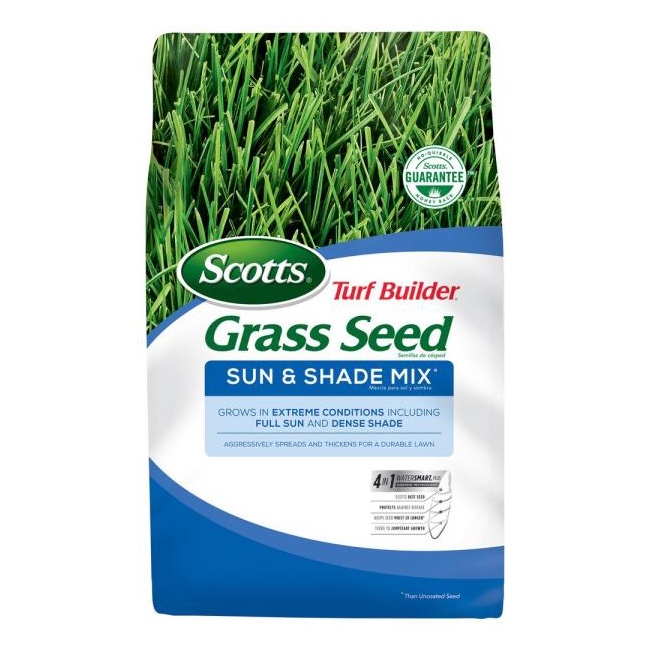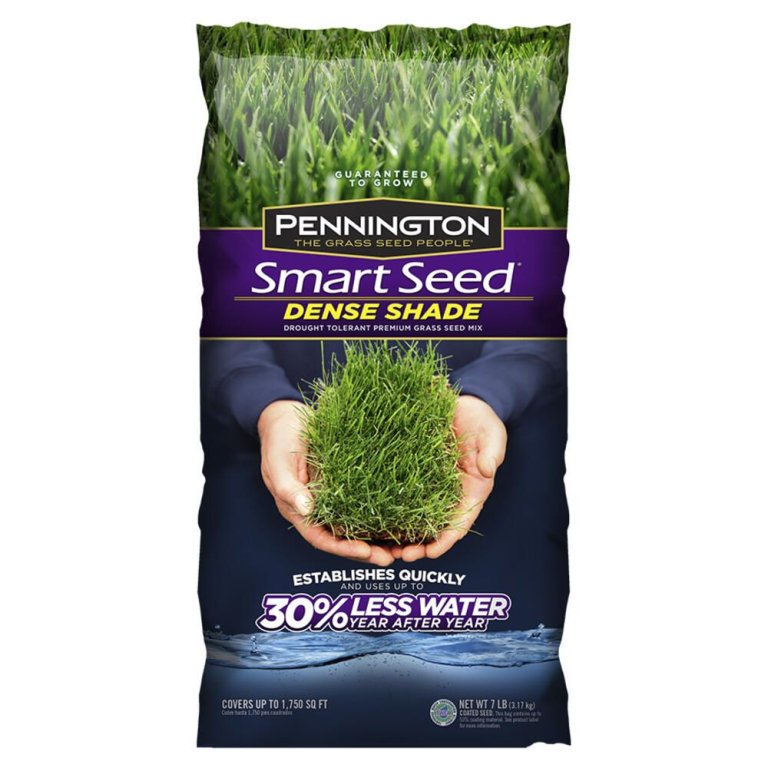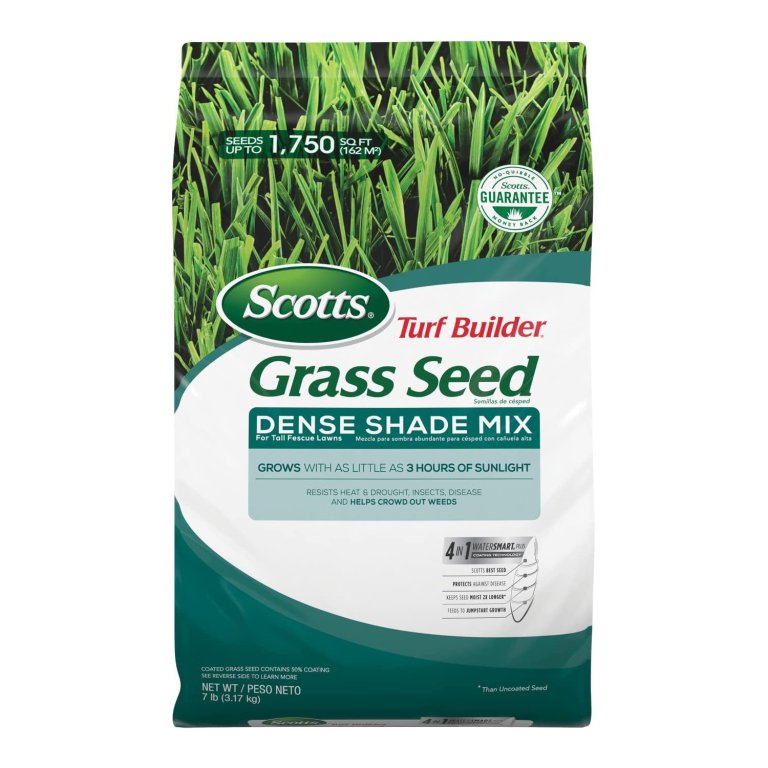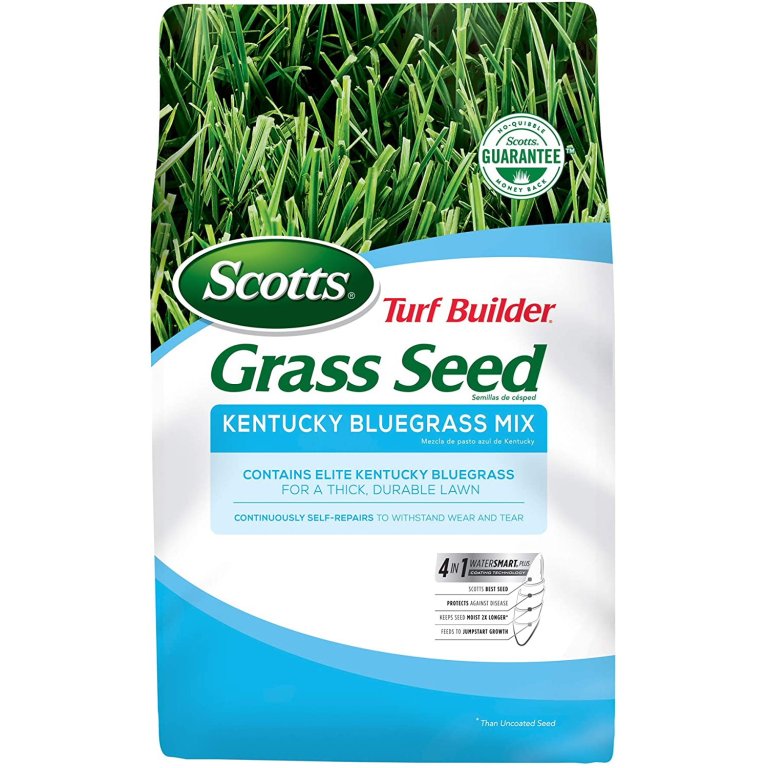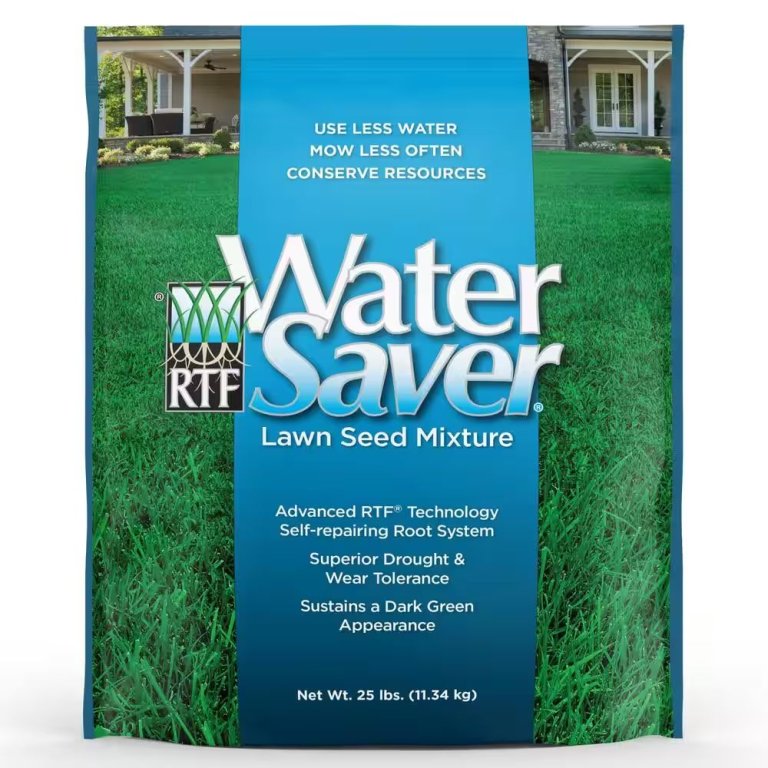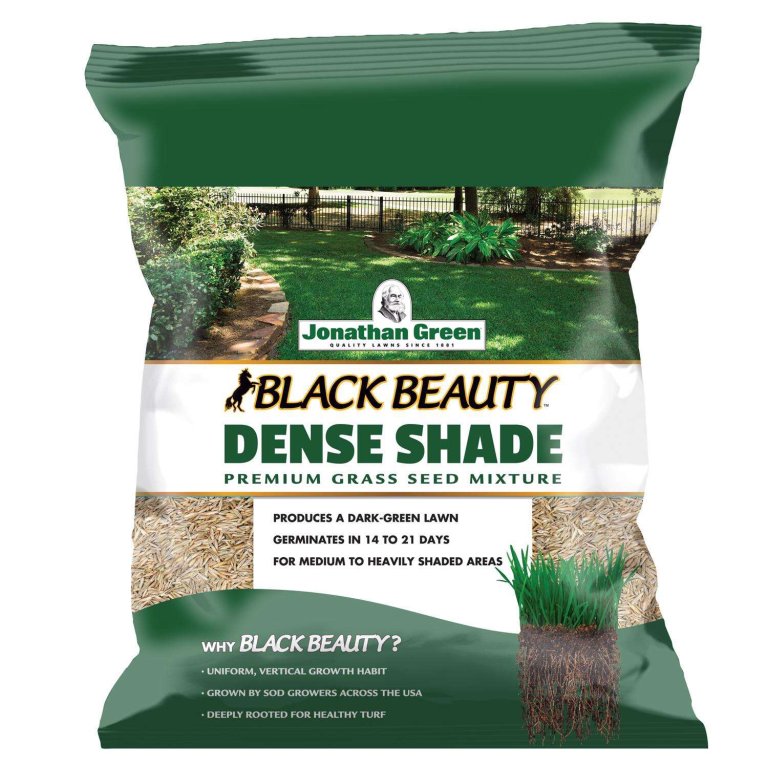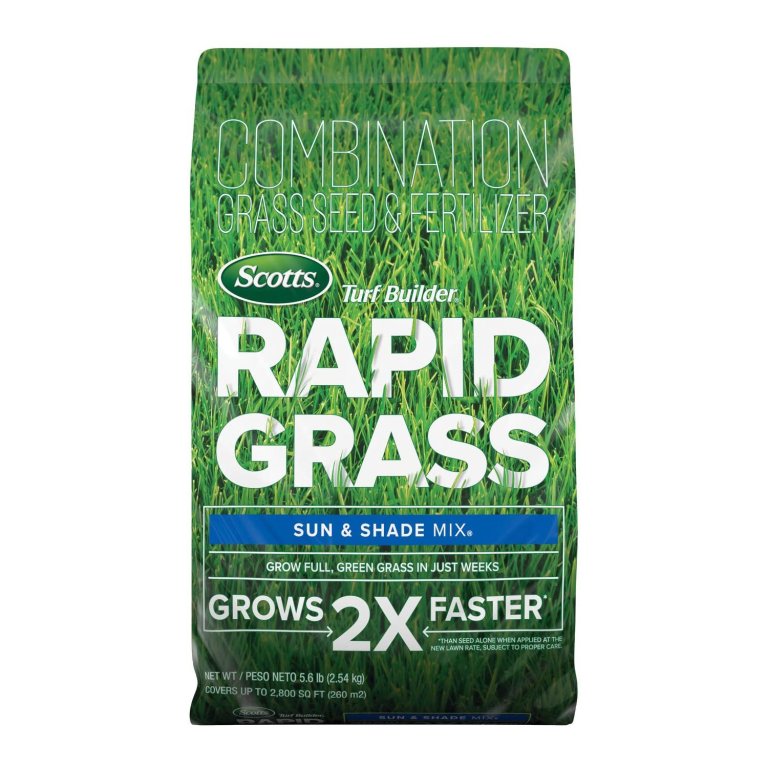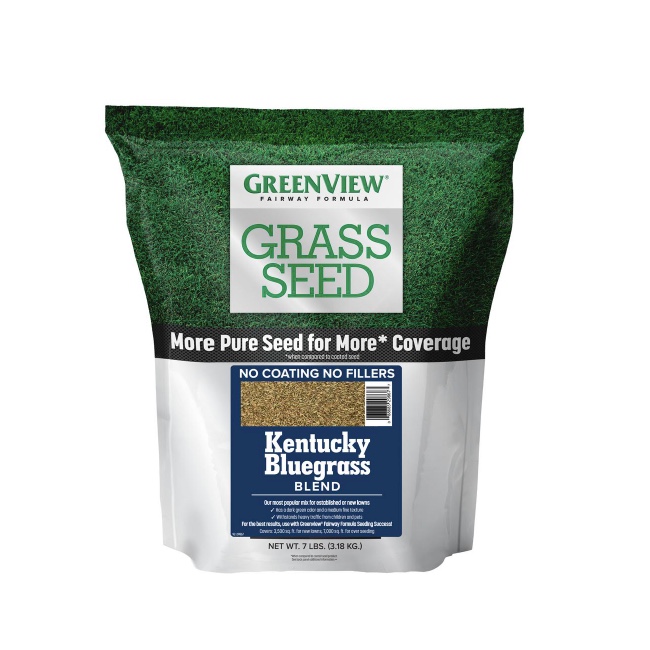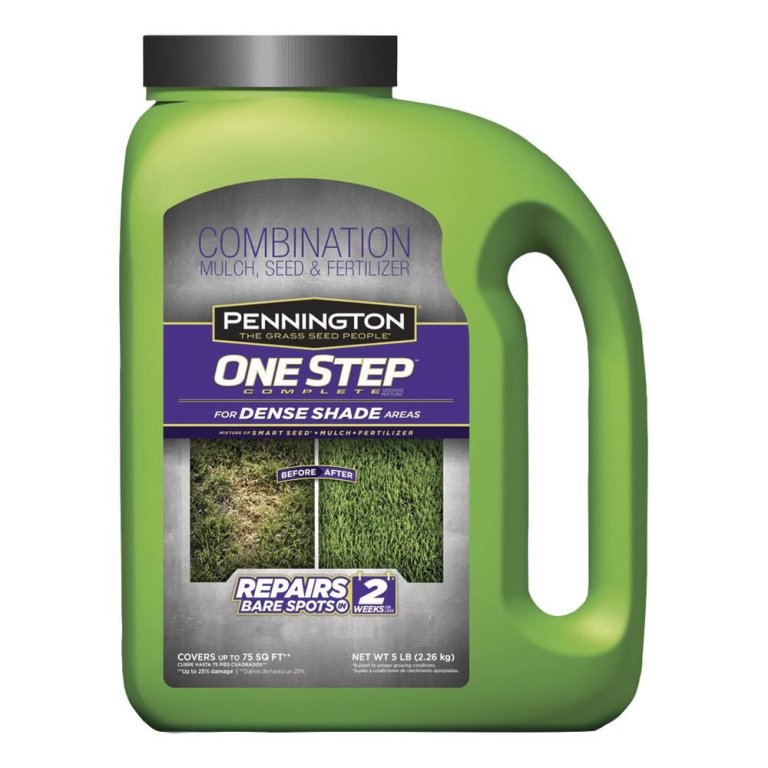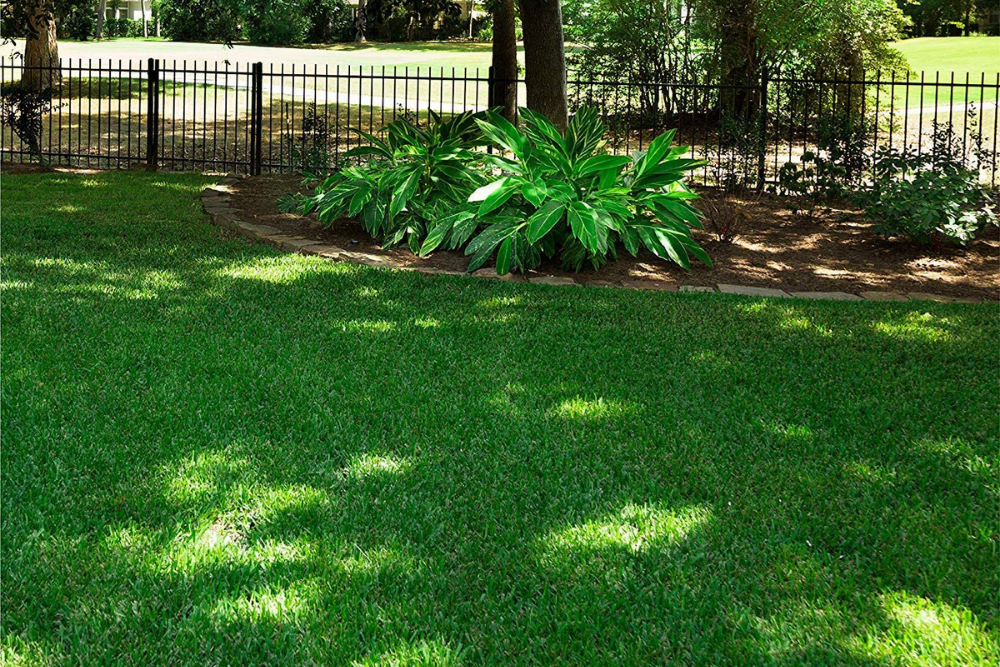
We may earn revenue from the products available on this page and participate in affiliate programs. Learn More ›
If the lawn in a sunny front yard is thriving but no grass seems to grow under a large shade tree, odds are it’s because the grass isn’t suitable for a shady spot. Most grasses are sun-oriented plants that develop to their maximum potential only when they receive 8 or more hours of direct sunlight per day. Fortunately, a few types of grass seed germinate and grow in medium to light shade, and a few more can survive even in dense shade.
Ahead, learn what to look for when choosing the best grass seed for shade and find out why the following types of grass seed are suitable for various shady situations.
- BEST OVERALL: Scotts Turf Builder Grass Seed Sun & Shade Mix
- BEST BANG FOR THE BUCK: Pennington Smart Seed Dense Shade Grass Mix
- BEST FOR DENSE SHADE: Scotts Turf Builder Grass Seed Dense Shade Mix
- BEST FOR LIGHT SHADE: Scotts Turf Builder Grass Seed Kentucky Bluegrass Mix
- BEST DROUGHT-RESISTANT: WaterSaver Grass Mixture With Turf-Type Tall Fescue
- MOST DISEASE-RESISTANT: Jonathan Green Black Beauty Dense Shade Grass Seed
- BEST FOR REPAIRS: Scotts EZ Seed Patch & Repair Sun and Shade
- FAST ESTABLISHMENT: Scotts Turf Builder Rapid Grass Sun & Shade Mix
- BEST FOR HIGH TRAFFIC: GreenView Fairway Formula Grass Seed
- ALSO CONSIDER: Pennington One Step Complete Dense Shade Bare Spot

Before You Buy Grass Seed for Shade
It’s important to note that even grass seeds specifically designed for dense shade still require a minimum amount of sunlight to thrive. In fact, for successful growth, grass typically needs at least 2 hours of direct sunlight or up to 6 hours of filtered light—such as dappled light through the leaves of a tree—each day.
While grass seed for shade is formulated to handle lower levels of light, it’s not a miracle solution for areas that receive no sunlight whatsoever. If your lawn is located in a completely shaded area, it’s likely that even the best shade-tolerant grass seed will struggle to grow.
Before purchasing grass seed, assessing the amount of sunlight your lawn receives throughout the day is essential. If your lawn doesn’t receive at least 2 hours of direct sunlight or up to 6 hours of filtered light per day, consider alternative options to grass, such as ground covers that thrive in full shade.
How We Chose the Best Grass Seed for Shade
We extensively researched dozens of grass seed products before selecting the ones in this lineup. We considered manufacturer reputation—both Scotts and Pennington are nationally known for their grass-breeding research programs—yet also looked closely at other companies that produce quality seeds. We judged the seed blends for versatility and their ability to withstand different levels of shade. Grass seed varieties that didn’t grow well in even light shade were eliminated.
While we gave attention to added ingredients, such as fertilizers and coatings that help ensure uniform germination, we didn’t eliminate noncoated seeds as long as they offered high germination rates. Fertilizer can always be added to the soil separately.
Our Top Picks
To qualify for a spot in this lineup, we chose seed types that grow grass in various shady situations, such as light shade, sun and shade, moderate shade, and dense shade. Some selected products feature coated seeds, while others offer untreated bare seeds. However, all the following products are well suited for establishing grass in shady spots.
Best Overall
Scotts Turf Builder Grass Seed Sun & Shade Mix
Pros
- Blended for both sun and shade, making this suitable for most lawns
- Shade-tolerant in areas with as little as 4 hours of sun per day
- Scotts WaterSmart PLUS coating helps to retain moisture and fertilize seedlings
Cons
- Not for areas that receive less than 4 hours of sun per day
Product Specs
- Quantity: 20 pounds
- Coverage: Up to 8,000 square feet
- Coated: Yes
Since most lawns receive a combination of both sun and shade, Scotts developed Turf Builder sun-and-shade mix grass seed, which contains seed types that can grow grass in both situations. The blend includes a variety of fescue, perennial ryegrass, and bluegrass seeds coated with Scotts WaterSmart PLUS coating, which is eco-friendly, helps retain moisture while the seeds are waiting to germinate, and provides fertilizer to boost seedling growth.
This 20-pound bag of grass seed covers up to 8,000 square feet, and it can be spread uniformly in both sunny and shady spots in the yard. The shade-tolerant grass varieties in this blend grow in areas with as little as 4 hours of sunlight per day.
Get the Scotts Turf Builder sun-and-shade mix grass seed for shade at Lowe’s or Scotts.
Best Bang for the Buck
Pennington Smart Seed Dense Shade Grass Mix
Pros
- Tolerates dense shade that receives 2 to 6 hours of sun per day
- This mixture contains improved varieties to better withstand foot traffic
- The Smart Seed coating aids in moisture retention and feeds seedlings
Cons
- Penkoted seeds contain the potentially toxic chemical Mefenoxam
Product Specs
- Quantity: 7 pounds
- Coverage: Up to 1,750 square feet
- Coated: Yes
This shade-tolerant blend thrives in low-light areas of the yard. Pennington’s Smart Seed for dense shade contains improved varieties of tall fescue and fine fescue that can grow in areas that receive 2 to 6 hours of sunlight per day, making it suitable for spots on the north side of a fence or house.
The seed is coated to help absorb and retain moisture during the germination phase and to feed the new seedlings after they sprout. The brand’s proprietary Penkoted seeds also help protect new seedlings from disease. One downside, however, is that the coating contains Mefenoxam, which can be toxic to some wildlife if consumed in large quantities.
The fescue varieties in this blend produce a more resilient lawn that can withstand foot traffic better than other shade-tolerant grass varieties. The 7-pound bag covers up to 1,750 square feet.
Get the Pennington Smart Seed grass seed for shade at Menards.
Best for Dense Shade
Scotts Turf Builder Grass Seed Dense Shade Mix
Pros
- This seed mix tolerates as little as 3 hours of sun per day
- Scotts WaterSmart PLUS coating helps to retain moisture
- A starter fertilizer is included to help fertilize seedlings
Cons
- This shade-only blend isn’t suitable for sunny lawns or those with mixed sun and shade
Product Specs
- Quantity: 7 pounds
- Coverage: Up to 1,750 square feet
- Coated: Yes
For those trouble spots that defy most shade-tolerant grass seeds, check out Scotts Turf Builder Dense Shade mix. It can withstand even dense shade in areas that receive no more than 3 hours of sunlight per day. These seeds are treated with Scotts WaterSmart PLUS coating to absorb moisture and retain it during the germination process, which helps reduce the risk of the seeds drying out before they sprout. The coating also feeds the new seedlings to help get them off to a good start.
Unlike sun/shade blends, this grass seed is for shade only and can’t abide bright, sunny areas. If other areas of the yard are sunny, consider seeding them with a tall fescue variety that tolerates sun to establish a uniform look throughout the yard. This 7-pound bag covers up to 1,750 square feet. Other bag sizes may be available from some retailers.
Get the Scotts Turf Builder Dense Shade grass seed for shade at Lowe’sor Scotts.
Best For Light Shade
Scotts Turf Builder Grass Seed Kentucky Bluegrass Mix
Pros
- This grass seed is well suited for both sunny and shady areas
- Scotts WaterSmart PLUS coating helps the seeds to retain moisture
- A starter fertilizer is included to provide essential nutrients for seedlings
Cons
- Not suitable for areas that receive less than 6 hours of sunlight
Product Specs
- Quantity: 7 pounds
- Coverage: Up to 4,660 square feet
- Coated: Yes
Create a seamlessly smooth lawn that extends from the sunny areas into lightly shaded spots that receive 6 to 8 hours of sunlight per day with Scotts Turf Builder Kentucky bluegrass mix. This blend contains improved bluegrass varieties designed to thrive in multilight situations.
These seeds are coated with Scotts’ WaterSmart PLUS coating that absorbs and retains moisture to keep the seeds from drying out during germination. The coating also contains fertilizer to boost young seedling growth. A 7-pound bag of Scotts bluegrass mix can cover an area of up to 4,660 square feet. Additional sizes may be available.
Get the Scotts Turf Builder Kentucky bluegrass grass seed for shade at Ace Hardwareor Lowe’s.
Best Drought-Resistant
WaterSaver Grass Mixture with Turf-Type Tall Fescue
Pros
- Spreads through rhizomes in order to prepare the grass for droughtlike conditions
- The seeds develop deep roots that help reduce watering requirements
- Tolerates both sun and moderate shade for added versatility
Cons
- Rhizome can spread into flower beds, so this grass seed isn’t ideal for all lawns
Product Specs
- Quantity: 25 pounds
- Coverage: Up to 5,000 square feet
- Coated: No
This WaterSaver grass mixture contains the only turf-type fescue that develops rhizome (stems that branch horizontally under the soil), which helps the grass spread and gives it added resistance in slight-drought conditions. A blend of tall fescue and rhizomatous tall fescue seeds, the grass develops into a thick lawn that can stand up to increased foot traffic and repair itself through rhizome spread.
WaterSaver grows in both sunny and moderately shady areas that receive 4 to 6 hours of sunlight per day. This seed is not coated, so it goes further—a 25-pound bag can cover up to 5,000 square feet. Other sizes may be available from some retailers.
Get the WaterSaver grass seed for shade at The Home Depot or Tractor Supply Co.
Most Disease Resistant
Jonathan Green Black Beauty Dense Shade Grass Seed
Pros
- These seeds are designed to resist disease and insect infestation
- Can tolerate as little as 2 hours of sun per day
- The mixture is formulated to produce grass with a deep green color
Cons
- These seeds are not suitable for sunny areas
Product Specs
- Quantity: 3 pounds
- Coverage: Up to 1,800 square feet
- Coated: No
In lawns with a history of disease, such as brown patch or leaf spot, Jonathan Green’s Dense Shade mix may be the solution. The seed is produced from endophyte-enhanced strains of grass, which contain beneficial mycelium (mushroom-based) fungi that help grass resist diseases. In general, treatment with endophytic fungi results in grass types that show improved vigor and resistance to insect infestation.
This specific blend contains a mix of fescue, perennial ryegrass, and bluegrass. It produces a healthy dark green lawn that tolerates medium-to-dense shade conditions. It doesn’t perform as well in bright sunny spots. The seed is uncoated, and a 3-pound bag covers up to 1,800 square feet.
Get the Jonathan Green grass seed for shade at Ace Hardware.
Best for Repairs
Scotts EZ Seed Patch & Repair Sun and Shade
Pros
- This product is specially designed for spot treating bare spots
- These grass seeds come with mulch and fertilizer to nourish seedlings
- The tackifier in the formula helps keep seeds from washing away
Cons
- This product is not suitable for use in a seed spreader
Product Specs
- Quantity: 20 pounds
- Coverage: Up to 445 square feet
- Coated: No
Lawn disease, insect infestations, excavations to repair buried lines—all can damage lawns, leaving them sparse or patchy. Scotts EZ Seed Patch & Repair is formulated for reseeding trouble spots when reseeding the entire lawn is not an option. The blend contains fescue and Kentucky bluegrass seeds to use on problem spots in sunny or shady areas.
To address the problem of seeds washing away, Scotts has amended the mix with a tackifier—an ingredient that helps the seeds adhere to the soil. The product also contains mulch, which absorbs and retains moisture during the germination process, and fertilizer to help tiny seedlings grow. The 20-pound bag can seed up to 445 square feet.
Get the Scotts EZ Seed grass seed for shade at Amazon, Lowe’s, The Home Depot, or Target (for 3.75 pounds).
Fast Establishment
Scotts Turf Builder Rapid Grass Sun & Shade Mix
Pros
- This grass seed is designed to germinate and grow quickly
- The seed is suitable for both sunny and moderately shaded areas
- Added fertilizerhelps to nourish seedlings as they grow
Cons
- Since these seeds are not coated, they won’t retain moisture as well as coated seeds
Product Specs
- Quantity: 5.6 pounds
- Coverage: Up to 2,800 square feet
- Coated: No
Some types of grass seed, such as buffalo, are slow to germinate and grow, but not Scotts Turf Builder Rapid Grass Sun & Shade mix. It contains a proprietary blend of bluegrass, ryegrass, and fescue chosen for their quick-growing properties. Plus, the seed adapts to both sunny and shaded areas of the yard.
Scotts amended this fast-growing grass seed with fertilizer to get the seedlings off to a strong start, and the company promises results in just 21 days. It’s uncoated seed, and a 5.6-pound bag can seed up to 2,800 square feet. Other sizes may be available.
Get the Scotts Turf Builder Rapid grass seed for shade at The Home Depot or Target.
Best For High Traffic
GreenView Fairway Formula Grass Seed
Pros
- This mixture is designed for increased resistance to foot traffic
- The grass will grow in either sun or moderate shade
- These seeds will produce grass with a dark green color
Cons
- These seeds aren’t suitable for warmer regions
Product Specs
- Quantity: 7 pounds
- Coverage: Up to 7,000 square feet
- Coated: No
Grasses that grow in the shade are often on the tender side. GreenView Fairway Formula is formulated to withstand increased foot traffic without suffering damage. The Fairway grass seed contains no added fertilizers or mulches, and it’s a bare-seed product—no coating of any sort. The entire blend consists of improved Kentucky bluegrass seed varieties.
For the highest level of traffic resistance, grow Fairway Formula in the upper half of the U.S. in either sunny or moderately shaded areas that see at least 4 hours of sunlight per day. This blend comes in a 7-pound bag that covers up to 7,000 square feet.
Get the GreenView grass seed for shade at The Home Depot.
Also Consider
Pennington One Step Complete Dense Shade Bare Spot
Pros
- The seeds are coated to retain moisture during germination
- Contains mulch and fertilizer to feed seedlings as they grow
- These seeds are suitable for both warm and cool regions
Cons
- Pennington’s coated seeds can potentially be toxic to wildlife
Product Specs
- Quantity: 5 pounds
- Coverage: Up to 75 square feet
- Coated: Yes
Small areas, such as the bare ground beneath a shade tree, can be successfully planted with Pennington One Step Complete Dense Shade Bare Spot mix. This grass seed contains a blend of fescue varieties that can be grown in both cooler and warmer regions. The seed is coated to absorb and retain moisture during the germination phase, and its professional-grade fertilizer helps seedlings grow.
One Step is shade-tolerant and can grow in areas that receive as little as 2 hours of sunlight per day. The mix also contains finely shredded wood mulch that retains moisture and offers a bit of cover for the seeds to help keep them from washing away before they sprout. A 5-pound bag covers up to 75 square feet.
Get the Pennington One Step grass seed for shade at Menards.
Jump to Our Top Picks
What to Consider When Choosing a Grass Seed for Shade
Owners of shady yards—or those with a combination of sunny and shaded areas in the same yard—often find it challenging to cultivate a lush lawn. Lawn grass loves the sun. However, grass seed producers have improved certain varieties to make them more shade-tolerant.
Types of the Best Grass Seed for Shade
The types of grass that do best in shade typically have thinner blades than sun-loving varieties. These thin-bladed types also have deeper root systems than wide-bladed grasses, which help them receive the nutrients they need through their roots. Some of the more common shade grass seed blends include one or more of the following:
- Creeping red fescue: A soft, fine grass that can tolerate moderate shade but still needs a few hours of sunlight.
- Tall fescue: Though it germinates quickly and can tolerate partial shade, tall fescue usually needs 4 hours of sunlight or dappled shade throughout the day.
- Bluegrass: This cultivar includes several types of grass that require full sun daily, but a few bluegrass varieties, such as saber, glade, and Bensun, can grow in spots that receive at least 4 hours of sun per day.
- Perennial ryegrass: One of the darker green grasses, most perennial ryegrass usually needs at least 4 hours of sunlight; some of the improved varieties can get by with only 2 hours.
- Centipede: This cultivar contains types that grow in both sun and partial shade, with shade-tolerant varieties, such as Tennessee hardy and oaklawn, that need about 4 to 6 hours of sunlight per day.
Coating and Fertilizer
Coatings on grass seeds absorb water and then release it slowly, helping the seeds to remain slightly damp to ensure the highest rate of germination. Some seed coatings also may contain fertilizer to give seedlings a boost when they sprout and fungicides to deter fungal diseases, such as brown spot or dollar spot, which can kill tender new grass.
The coatings, which often contain clay to help them adhere to the seeds, increase the weight of the product. As a result, a 1-pound bag of coated seeds has fewer actual seeds than a 1-pound bag of noncoated seeds. Coated seeds offer lower coverage rates, but they provide higher germination rates. Some coatings include ingredients that could be toxic to wildlife if consumed in large quantities. With regular use, however, most grass seed is relatively eco-friendly.
In addition, some manufacturers don’t always coat their seeds; instead, they combine them with a granular fertilizer that helps the new seedlings grow. Grass seeds planted in shade have less exposure to sunlight, which naturally encourages growth (photosynthesis). If the grass seed doesn’t come with fertilizer, either as a coating or mixed in, growers can add an all-purpose lawn fertilizer to the soil when sowing.
Foot Traffic
The delicate leaves of most shade-tolerant grasses won’t stand up to a lot of heavy foot traffic, so don’t plan to plant them where kids practice sports or dogs run and play. Among the more activity-tolerant grasses are some of the different types of tall fescues, which often are more robust than other varieties.
Thinner grass blades sometimes bend and get crushed under repeated foot traffic; in fact, simply walking daily in the same spot can quickly wear a path in many types of shade grass. An all-purpose grass fertilizer applied every 3 months during the growing season can help strengthen shade grass by supplying nutrients.
Climate
Grass seeds are defined as either “warm season” or “cool season,” and the two types prefer different temperatures and perform differently. Those who purchase grass seed from a local supplier usually don’t need to worry about whether it’s a warm season or cool season type because the supplier usually sells only those varieties that thrive in that particular area.
- Warm-season grasses: These grass varieties are best suited for areas that have hot summers with temperatures that reach 85 to 95 degrees Fahrenheit. They green up in late spring and go dormant in early fall. Warm-season grasses typically grow well in the southern half of the United States. Very few grass seed types are suitable for growing in shade in warm regions because the best warm-season grasses aren’t produced from seed but rather from plugs, such as St. Augustine and zoysia. However, some perennial ryegrass and centipede grass may be grown from seeds in shady spots in warm regions.
- Cool-season grasses: Better suited to the northern half of the country, cool-season grasses green up early in the spring when nighttime temps can still drop below freezing. Their growth slows during hot summer weather when the temperature rises above 80 degrees Fahrenheit. Cool-season grasses, which often are grown from seed, include a variety of fescue, bluegrass, and ryegrass types of grass.
Amount of Shade
The amount of shade in a particular part of the yard determines the best type of grass seed to plant in that spot. Follow these general guidelines when shopping for the best shade grass seed.
- Full sun: 8 hours or more of direct sun per day
- Light shade: 6 to 8 hours of sun per day
- Moderate shade: From 4 to 6 hours of direct sun or 6 to 8 hours of filtered sun per day
- Dense shade: Less than 4 but at least 2 hours of direct sunlight or filtered sun for 4 to 6 hours per day
Even the most shade-tolerant grass seed varieties are unlikely to grow with less than a minimum of 2 hours of sunlight per day. In this type of yard, a better option might be to plant a deep-shade-tolerant ground cover, such as periwinkle or various types of ferns.
Planting Area
Successfully growing shade grass requires preparing the planting area before sowing the seeds. Most grass varieties prefer asoil pH of 6.5 to 7. The pH scale runs from 0 to 14, with 7 considered neutral. Numbers below 7 are progressively more acidic, and numbers above 7 are progressively more alkaline.
An inexpensive pH tester, which is available online or at garden centers, can quickly determine the pH of the soil. If it’s too acidic (lower than 6.5), consider broadcasting ground lime to raise the pH. If the soil is too alkaline (higher than 7), add a sulfur-type fertilizer to reduce alkalinity. Follow the product’s application instructions for the best results.
FAQs
Growing grass in shady spots of the yard can be tricky, but today’s shade-tolerant seed blends can help. Those looking to establish a lawn where sunlight is limited may still have some questions. Keep reading for answers to some of the most common.
Q. When should I seed my shady lawn?
The ideal time to seed your shady lawn depends on the type of grass you’re planting. Warm-season grasses, such as Bermuda grass and zoysia grass, should be planted in the spring after the nighttime temperatures have consistently stayed above freezing. Depending on your location, this is typically between late April and early June.
Cool-season grasses like Kentucky bluegrass and tall fescue perform best when planted in the fall. This allows the grass to establish strong roots and grow before the summer heat arrives. The best time to plant cool-season grasses is typically in late summer or early fall, in August through September, depending on the climate in your region.
Q. Will my grass grow if it’s in the shade?
The amount of shade in your lawn can significantly impact the growth and overall health of your grass. While some grass varieties are more shade-tolerant than others, all grasses require a minimum amount of sunlight to thrive. If your grass is in complete shade and receives no direct sunlight, it may not grow at all.
However, if your lawn receives at least 2 hours of sunlight per day, there’s a good chance that shade-tolerant grass will grow, although it may not be as lush or thick as grass in a sunny area.
Q. How long does it take for grass to grow in shade?
The length of time it takes for grass to grow in the shade can vary depending on the type of grass you’ve planted and the specific growing conditions. Some grass varieties are fairly quick to germinate and establish, while others may grow more slowly or take longer to establish in low-light areas.
Fescue varieties are the quickest to germinate—as soon as 2 weeks in some cases. Buffalo grass seed can take 3 weeks or longer to germinate, and it grows slowly.
Q. How often should I water shade grass?
The frequency with which you need to water your shade grass will depend on a variety of factors, including the type of grass, soil type, and weather conditions. When you first plant your grass seed, it’s important to keep the soil moist but not waterlogged until the seeds have germinated. This typically involves watering the area every day or every other day to ensure the soil stays damp.
Once the seeds have germinated, continue to water the grass frequently for the next 3 weeks. After that, you can gradually reduce the frequency of watering to once per week or as needed based on weather conditions.
